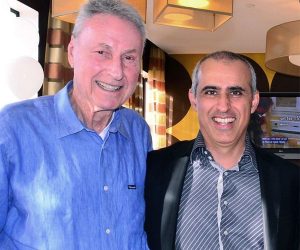- Home
- Resource Library
- IOL (Intraocular lens) & ICL (Implantable contact lens)
- The History of IOLs
The History of IOLs
An intraocular lens (IOL) is a lens, often for vision correction after cataract surgery, that is surgically implanted in your eye.
Today, we are in a golden age for those who want exceptional vision correction with cataract surgery or refractive lens exchange (RLE). Today’s state-of-the-art IOLs can provide LASIK-level (or even better) vision quality, sometimes eliminating the need for glasses or contact lenses.
When patients come to the Assil Gaur Eye Institute (AGEI) to learn which intraocular lenses would best suit their visual needs, they quickly discover that there are many options. These include trifocal, extended depth of focus, and monofocal lenses, all from a myriad of manufacturers.
Fortunately, Assil Gaur Eye Institute patients benefit from the decades of experience and expertise of the institute’s ophthalmologists, ODs, and staff.
Their experience and proprietary algorithms allow them to select the best lenses for each patient.
The early beginnings of IOLs
The first step toward today’s miracle IOLs began 3,000 years ago in India and was practiced for centuries in China, Greece, and the Middle East. The practice was called “couching”. The goal of this ancient surgical technique was to remove the vision loss caused by cataracts. This ancient method involved dislocating the eye’s clouded lens and pushing it into the vitreous cavity (the back of the eye) to restore some level of vision.
Unfortunately, this procedure often led to complications like inflammation, glaucoma, or complete blindness. So, while there were some positive results, let’s just say that early cataract correction was far from satisfactory.

Enter the modern era of cataract eye lens replacement surgery
The next major step toward intraocular lens implants transforming cataract surgery came in the 20th century. In 1949, Sir Harold Ridley, a pioneering British ophthalmologist, noticed something interesting in the eyes of World War II fighter pilots.
At that time, the fighter plane canopies (the clear “roof” over the pilot’s head) were made of acrylic plastic (polymethylmethacrylate [PMMA]). Ridly discovered that when tiny pieces of this plastic got stuck in the eyes of injured pilots, it did not cause them any serious problems.
This led Ridley to come up with the idea for the first IOL. He ingeniously thought he could create an artificial lens made from a similar material. This lens would then be implanted in the eye to replace the natural lens removed during cataract surgery and refractive surgery.
Over time, Ridley’s work gained widespread recognition, and by the 1980s, IOL implantation had become a standard treatment for cataracts.
The major contributions of Drs. Charles Kelman and Robert Sinskey

Another IOL pioneer was Dr. Charles Kelman. In 1967, Kelman introduced phacoemulsification, a revolutionary surgical technique for cataract removal. This technique uses ultrasound waves to break up a cataract into tiny pieces. The pieces are then gently suctioned out. The surgeon then implants a clear artificial lens (IOL) to restore vision.
Another IOL pioneer was ophthalmologist Dr. Robert M. Sinskey. Dr. Sinskey made enormous contributions to cataract surgery and intraocular lens (IOL) development throughout his career. He significantly refined surgical techniques, particularly in small-incision cataract surgery.
Dr. Sinskey (founder of what is now known as the Assil Gaur Eye Institute) is credited with pioneering small-incision cataract surgery, particularly through his advancements in phacoemulsification techniques and lens implantation.
In addition, he was key in refining and popularizing small-incision cataract surgery by improving intraocular lens (IOL) implantation methods in the 1970s and 1980s. This led to the revolutionary foldable IOL, which required a much smaller incision to insert into the eye.
Sinskey’s work allowed many advances in modern cataract surgery, helping to make it safer, with faster recovery times and better visual outcomes.
The 1980s brought us more exciting IOL lens advances
The first generation of modern IOLs was introduced almost 40 years ago, with the FDA approval of the 3M diffractive multifocal IOL in 1987.
Then, in 1992, the Array IOL was developed, which combined aspheric and spherical optical surfaces with progressive transitions between zones to improve image quality.
The 3M and Array lenses were called “refractive optic lenses.” In other words, they had circumferential rings dedicated to focusing on different distances. They were revolutionary in their time, as all other prior IOL lenses could only focus on a single distance.
However, these lenses could not offer crisp visual clarity over all distances. Furthermore, many patients reported distracting visual halos and glare.
The birth of the Assil Gaur Eye Institute and 3rd generation IOLs
In 1995, Dr. Robert Sinskey invited Dr. Assil to pursue their mutual vision of building a world-class private eye institute in Los Angeles. Dr. Assil became Chairman and Medical Director of the Sinskey Institute, which grew into what is known today as the Assil Gaur Eye Institute.
Ten years later, the third-generation IOL lenses, the ReSTORE (by Alcon) and ReZoom® (by AMO), were introduced. ReSTORE utilized a combination of refractive (dedicated ringlets) and diffractive lenses, which differentially focus incoming light based on the object’s distance. At the same time, ReZoom optimized the refractive lens system with “a dedicated ringlets concept.”
Both of these lenses improved clarity of vision with better contrast sensitivity (discerning “shades of grey”). However, they were highly affected by pupil size, with ReSTORE performing better in dimmer light and ReZoom performing better in brighter lighting.
Because one lens performed better with near vision while the other performed better at intermediate distance, they complemented one another. This resulted in surgeons “mixing and matching” them, with one of each lens often placed in the eyes of the same patient.
Enter the 4th generation of IOLs
In 2009, the FDA approved the Tecnis Multifocal 4, the fourth-generation IOL lens. This lens provided superior vision, with excellent clarity for near and far vision but not for intermediate distances.
Over the last nine years, many fourth-generation lenses have emerged. These include improved extended-depth-of-focus and bifocal lenses, such as the Technic (2016), Symfony (2016), PanOptix (2019), Vivity (2020), Synergy (2021), Eyhance extended-depth-of-focus lens (2021), and ClearView refractive bifocal lens (2022).
These lenses significantly improved the clarity and range of vision and reduced the side effects of halos, glare, and starbursts. Many also came in Toric versions to treat astigmatism.
In late 2024, the 5th generation of IOL lenses was launched!
At the end of 2024, some incredible fifth-generation IOL lenses entered the market, and Assil Gaur Eye Institute was the first to test them in the United States.
Many believe these lenses offer comparable, if not better, results than LASIK surgery. These lenses include the Johnson and Johnson PurSee and Odyssey lenses and the Bausch + Lomb’s enVista Envy IOL.
Results show that these lenses offer even greater clarity of vision (called contrast security) and a full range of vision than any prior-generation lens. Most impressively, studies have shown that patients with these lenses implanted were 98% satisfied.
Because every patient’s eyes are different, no one lens is right for everyone. Lifestyle and anatomical parameters, such as corneal curvature and pupil size, are carefully considered when choosing the best IOL for each patient.
Assil Gaur Eye Institute surgeons have a second-to-none success rate due to their vast experience and proprietary algorithms, which help ensure the right lens is chosen the first time.
The Assil Gaur Eye Institute nationally recognized experts in IOLs for premium cataract and RLE surgery
The Assil Gaur Eye Institute (AGEI) is renowned for its expertise in refractive lens exchange and premium cataract surgery.
Their eyecare team of seasoned ophthalmologists and optometrists is among the most experienced in the United States. They specialize in monocular, myopia, and multifocal IOLs, LASIK, PRK, cataract surgery, and RLE.
With its cutting-edge technology and commitment to patient care, AGEI provides highly patient-satisfying advanced treatments for various conditions, including hyperopia, emmetropia, bilateral implantation, glaucoma, macular degeneration, presbyopia-correcting retinal issues, corneal conditions, and trifocal intraocular lenses.
Take the first step toward crystal-clear vision—call (866) 945-2745 to schedule your consultation or request an appointment online.
Intraocular Lens FAQs
What is the lifespan of an intraocular lens?
An intraocular lens (IOL) is designed to be permanent and typically lasts a lifetime. Made from biocompatible materials like acrylic, silicone, or polymethyl methacrylate (PMMA), IOLs do not degrade, wear out, or need replacement under normal circumstances.
While the IOL itself does not deteriorate, some patients can develop capsule opacification (PCO)—a clouding of the lens capsule behind the IOL—which can be easily treated with a quick YAG laser capsulotomy to restore clear vision.
Do intraocular lenses need to be replaced?
IOLs are supposed to last a lifetime, though on rare occasions, they may need to be replaced. Examples include:
- Dislocation or shifting of the lens.
- Visual disturbances (such as glare, halos, or incorrect power selection).
- Damage from trauma or complications like infection.
- Advancements in technology, where a patient opts for a newer IOL for better vision.
- The patient was given the wrong lens type, which can lead to IOL revision surgery, in which a new, appropriate lens replaces the old one. Assil Gaur Eye Institute of Los Angeles is among the leading practices that corrects other surgeons’ work.
Sources
Harold Ridley and the invention of the intraocular lens
https://www.surveyophthalmol.com/article/S0039-6257(96)82003-0/abstract
A tribute to Charles David Kelman MD: ophthalmologist, inventor and pioneer of phacoemulsification surgery
https://onlinelibrary.wiley.com/doi/10.1111/j.1442-9071.2004.00887.x
Ridley, Harold – American Academy of Ophthalmology
https://www.aao.org/biographies-detail/harold-ridley-md
Combination of Toric and multifocal intraocular lens implantation in bilateral cataract patients with unilateral astigmatism
https://pmc.ncbi.nlm.nih.gov/articles/PMC5154990/
Optical bench performance of AcrySof® IQ ReSTOR®, AT LISA® tri, and FineVision® intraocular lenses
https://pmc.ncbi.nlm.nih.gov/articles/PMC4206402/
Extended Depth-of-Field Intraocular Lenses: An Update













